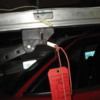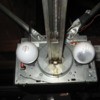I have a 4 post stacker in my garage with one Pantera on top, where I have the garage door shut off switch fixed further down the rail so that when the garage door opens it hits this switch early on before the garage door rams into the windshield. I have always been cautious about this switch and watch the door as I open it, to ensure it shuts off where it is supposed to when it comes in contact with this white plastic switch shown in the photo. But today, the door went past the switch, and lucky I shut it down before the door hit the windshield. So I cleaned the contacts of the switch and who knows maybe that helps, or maybe not. But anyone know of another second safety I could use, mechanical or electrical that would be a back up in case that switch fails again? Since passing 55 I am not fast on my fingers like I used to be to shut it down and would like some second safety other than my finger on the door remote.
Attachments
Original Post




